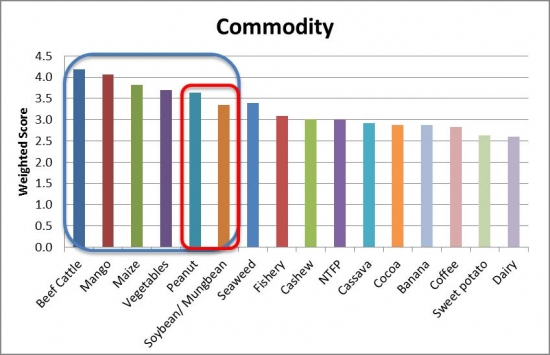An objective process of prioritisation was undertaken in order to select the final commodities for detailed value chain analysis.
The information collected in the commodity literature reviews and briefs, consultation feedback and the Socio-economic review was used to inform the commodity prioritisation process.
In order for the commodities to be prioritised, selection criteria were established and then weighted according to their level of importance to the achievement of AIP-PRISMA (PDF 344 KB) goals.
The selection criteria used to prioritise the commodities incorporated issues such as integration of the poor into markets, product potential for growth, opportunity for scaling up, risk, number of households impacted, poverty incidence and extent. Consideration was also given to factors such as environmental impact, long-term sustainability and gender.
Poverty alleviation and sustainability of the economic activity: 60%
| # | Criteria | Weighting | Rationale |
|---|---|---|---|
| 1. | Is there potential to reach large numbers of poor households in production and post-production? | 30% | AIP-Rural goal to reach one million poor male and female producers in EJ, NTT and NTB over 10 years |
| 2. | What is the potential to sustainably increase income for producers? | 30% | AIP-Rural goal is to increase incomes of poor male and female producers by 30% over 10 years |
| 3. | Does the chain/commodity fit with the focus of Government programs and priorities? | 10% | AIP-Rural goal is to collaborate closely with Government of Indonesia's priorities and programs |
| 4. | How project-crowded is the sector? To what extent are sector needs addressed by current donors? | 5% | Aims not to compete or duplicate, but to complement existing initiatives |
| 5. | What is the agro-ecological feasibility? | 10% | The commodity should be well suited to the biophysical constraints of East Java, NTT and NTB |
| 6. | Is it environmentally sustainable? | 10% | To assure project sustainability |
| 7. | External risks | 5% | To assure project sustainability |
Structure of the value chain: 40%
| # | Criteria | Weighting | Rationale |
|---|---|---|---|
| 1. | Is there potential for post harvest productivity/ value-added? | 30% | AIP-Rural supports better access to input and output markets |
| 2. | What is the potential for improving market access? | 30% | AIP-Rural supports better access to input and output markets |
| 3. | What is the scalability and transferability potential? | 25% | To ensure lessons learned from the study be up-scaled to the national level and the lessons learned transferable to other sectors |
| 4. | Is there sufficient infrastructure availability? | 15% | To assure project feasibility |

